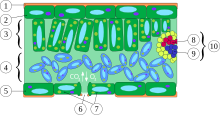
[Photo credit: Foobar]
Importance of Transportation
The importance of transportation in plants and animals include:
- to get rid of metabolic waste products, e.g urine, carbon dioxide.
- to obtain all the essentials for metabolism e.g oxygen, water.
- to move mineral salts and water from the roots of plants to the stem and roots.
- to move hormones in plants from where they are produced to where they are needed.
- The movement of glucose in plants is as a result of transportation.
There are many materials that are transported in living organisms. The following explains the materials that are transported, where they are produced and where they are transported to.
Materials for Transport in Plants

The following are the materials transported in plants:
- Water: Water is absorbed by plants from the soil. The absorbed water is transported to the leaves, and some other parts, where they are needed, for photosynthesis and other purposes
- Excretory products: These are transported from the living cells to where they are excreted. Examples of the excretory products are carbon dioxide and ammonia.
- Manufactured food: Foods that are manufactured in the leaves during photosynthesis are transported to all living cells of the the body for tissue respiration or for storage.
Other materials that are transported in plants include:
- glucose
- amino acids
- oxygen
- mineral salts
- latex
- auxins
- hormones
Materials for Transportation in Animals

The following are materials that are transported in animals:
- Oxygen: Oxygen is transported from the lungs to other cells within the body for tissue respiration.
- Carbon dioxide: This is also an excretory product. It is transported from the their place of production to the lungs where it is finally excreted.
- Urea: This is an excretory product which is transported from the cells, to where they are excreted, e.g liver.
- Excess salts: These are produced from cells and transported to the skin and kidney for excretion.
- Sugars: Sugars are produced from starch and carbohydrate digestion. They are transported from the ileum to some cells for tissue respiration.
- Hormones: These are secreted by the endocrine glands. They are then transported to other organs on which they act.
- Antibodies: White blood corpuscles are responsible for the production of antibodies. They are transported by blood to the parts where they defend the body against infection.
Other materials include:
- water
- amino acids
- fatty acids and glycerol
- mineral salts
- vitamins
Reasons Transportation is Needed in Large Organisms
Transportation is needed in large organisms for the following reasons:
- to move substances over great distances.
- to connect isolated groups of cells.
- to help diffusion in transporting materials to isolated cells.
Other reasons include:
- Because the surface area to volume ratio in complex large animals is too small, efficient transport system is needed.
- Materials being transported are large in quantity for osmosis or simple diffusion to accomplish, therefore, efficient transport system is needed.
Means of Transportation
For transportation to take place, a means, usually fluid, is required. There are four common means of transportation:
- Blood: This is a very powerful means of transportation of materials in most animals, especially vertebrates. It can move large materials over the entire body through blood vessels - arteries, veins and capillaries. It is in fluid state.
- Lymph: This is also a means of transport in animals. It is a fluid, similar in composition to tissue fluid. Although it contains extra lymphocytes, red cell is not present. An example is the lateal, which transports fatty acids and glycerol.
- Cytoplasm: This is a means of transport in lower unicellular organisms, e.g Amoeba and Paramecium. It transports materials such as oxygen, glucose, amino acids, carbon dioxide, from one part of the cell to another.
- Cell sap or latex: This is a means of transport in plants. It is a concentrated solution situated in the vacuole of cells which serves as a stronger solution. It transports water and dissolved mineral salts from the soil to the upper parts of the plants through the root hairs.








0 comments:
Post a Comment